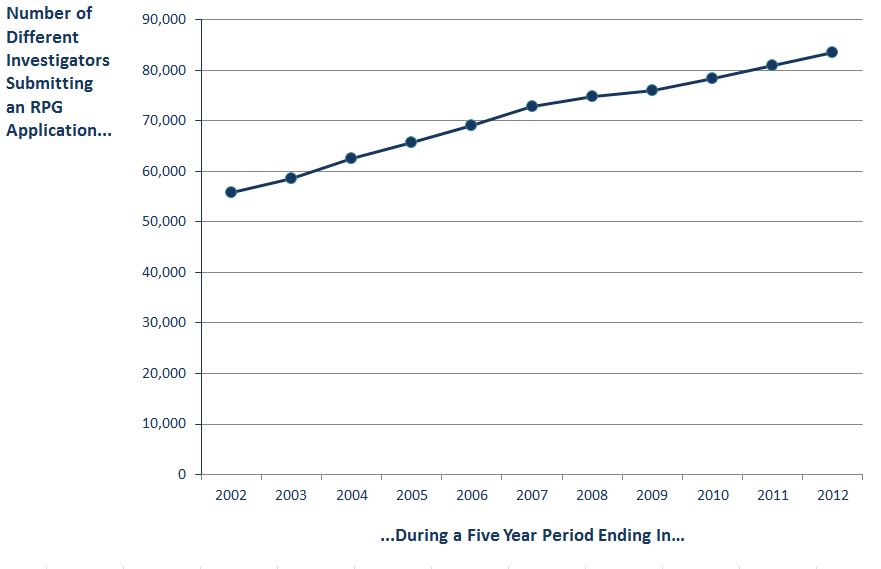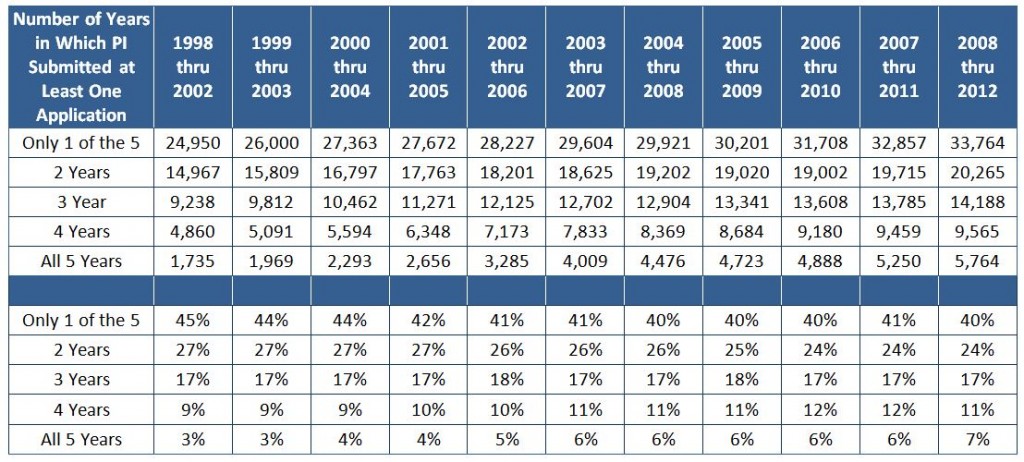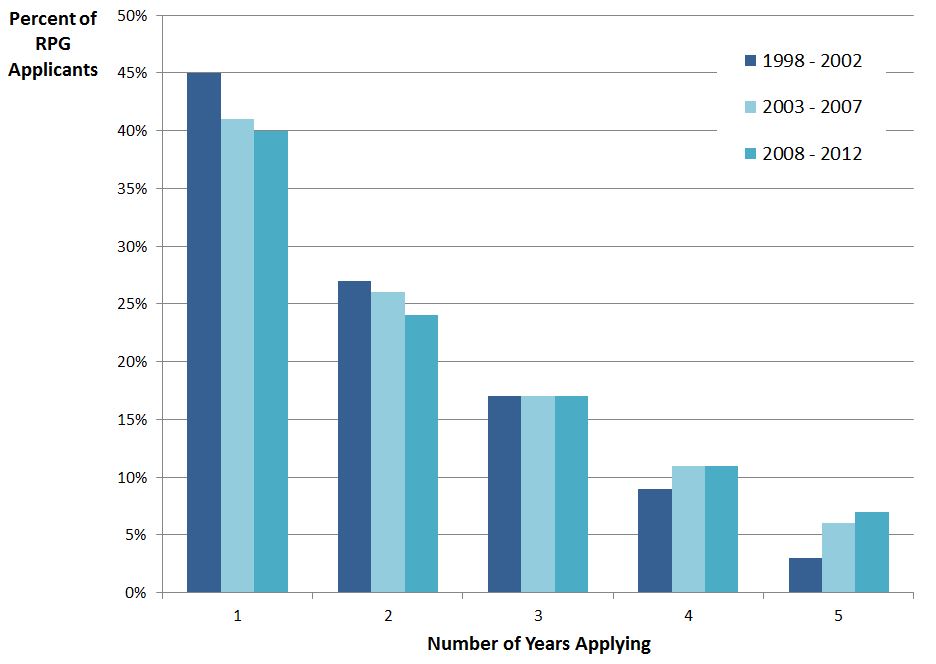6 Comments
Last August, I wrote on the number of investigators applying for NIH grants. Several readers correctly noted that the increase we showed in the number of applicants was based on the number of investigators submitting at least one application in a given year (rather than, say, all investigators “in the system”). In responses to this and other blog posts, commenters suggested this method of counting could create a misleading picture that suggests the number of individuals applying for grants has increased when it could simply be that the same individuals are submitting more often (e.g., applying every third year instead of every fifth year).
To examine this possibility, we looked at the number of different investigators applying for research project grants (RPGs; including both unsolicited and those submitted in response to requests for applications) over each five-year period from 1998 through 2012. The number of applicants increased from about 56,000 in the five years ending in 2002 to 83,500 in the five years ending in 2012, a 50% increase.
Applicants did apply more often, but the changes were rather small: the total number of applications per investigator in each 5-year period increased from about 2.7 to 3.1 (or from 0.54 applications per investigator per year to 0.62). The percentage applying in only one of the five years in each period decreased from 45% to 40% and the number of investigators applying in four or five of the years in each period increased from 12% to 18%.
It appears that application rates have been increasing continuously since 1998.
So which of these two factors, the number of applicants or application rate, has been the largest contributor to the increased number of RPG applications to NIH? It appears the number of applicants has contributed more. Let’s do the thought experiment. If there had been no increase in applicants and only the observed higher application rate (from 0.54 to 0.62 applications/investigator/year), the number of RPG applications would have grown 16% from 148,878 applications in 1998-2002 to about 170,000 in 2008-2012 instead of the 258,802 that we actually saw. On the other hand, as noted at the beginning of this blog, the increase in applicants alone would produce an increase of about 50%, from 148,878 to almost 225,000.
So thanks for all the comments, it spurred us to go back and look at these data again. This is one reason why I find this blog so useful.
Note: The data table corresponding to these figures is posted on RePORT and can be downloaded in an Excel file. The file also includes comparable figures for R01 applications.







There are a number of related questions that I would you or someone at NIH to address.
1. What is the success rate for renewal applications by investigators who received a new first R01 award?
2. What fraction of investigators receive one R01 and not another for, say, a minimum of five years?
3. What are current data for age at which a first R01 is obtained and the last (no new award for, say 10 years)?
A general question that these all relate to is what are the chances that a new assistant investigator will get one grant and then never another?
Interesting question HHW. But why limit yourself only to assistant professors? It would be fascinating to see the histogram of investigators binned by percentage of their time in the system that they have held funding as a PI.
Still depressing for funding prospects…
NIH needs to STOP incentivizing the creation of new applicants. Kill training grants and/or at least STRONGLY encourage the movement of PhDs into not-federally-funded-research careers.
There are lots of ways to do this. Just kill the training support. Cap the amount of training salary allowable for projects. Shift incentives so that pay goes to techs or anyone else that is not a PI wannabe but can get the science done. Kill support for academic programs. Stop the new investigator perks. Kill the K99s or change them so they facilitate transition from academia to industry. etc etc. We can’t allow the pyramid scheme to continue.
I think the USA needs to seriously consider setting up numerous research only institutes that are funded either fully by taxpayers, or in conjunction with industrial partners. This is what Germany does, as well as the Fred Hutch in Seattle. (I am just back from a German staff scientist position at a hospital doing brain tumor research.)
We’d want an even dispersal of these institutes across the nation (no putting them only in NY, CA, and MA), and fully transparent budgets- esp. with regards to institutional overhead costs. This way, the universities could get back to doing high quality STEM teaching and mentoring. Right now some of the PIs are so busy writing grants that they neglect to teach their students important things like lab safety.
Cancer research has a heck of a lot of “boring” replication studies it needs to do to verify published preliminary results from university labs. The universities should be focused on long term, risky goals; and the institutes on 3 to 5 year goals with readily applicable targets and a 7 to 10 year outlook.
These institutes could offer many stable, fairly well paying jobs with good benefits for skilled lab technicians at both the Master’s and PhD levels. Detecting and curing diseases like cancer will require massive amounts of parallel processing in labs across the nation, and these institutes could soak up the high numbers of PhDs in biology, genetics, molecular biology etc. within my generation.
I’ve written about the differences in STEM tracks for “industry PhDs” and “academic PhDs” in an essay comparing and contrasting the USA and German STEM educational system). The USA system is skewed towards producing “academic PhDs”, and the European system towards “industry PhDs”– but we need BOTH if we as a species are going to get serious about the collective effort required for curing sicknesses.
As a 3rd generation American chemist- and the first in her family to obtain a PhD- it is heart breaking for me to watch a funding system that was once the envy of the world slowly slide into the …. mess it has become today. We need to wake up as a nation and cooperate, not compete, to address the challenges presented to us by a large aging population. This shall not be solved by any one person, lab, department, university, city, or state. It will require massive collaboration on a federal level and a national commitment to our long term future.
Time to stop fighting, make budgets transparent, re-allocate funding and/or raise taxes, hire lab techs and put ‘em to work replicating and verifying preliminary findings in heath science research.
Sincerely,
Dr. Allison L. Stelling
PhD Stony Brook University Dept. of Chemistry
BA Reed College Dept. of Chemistry